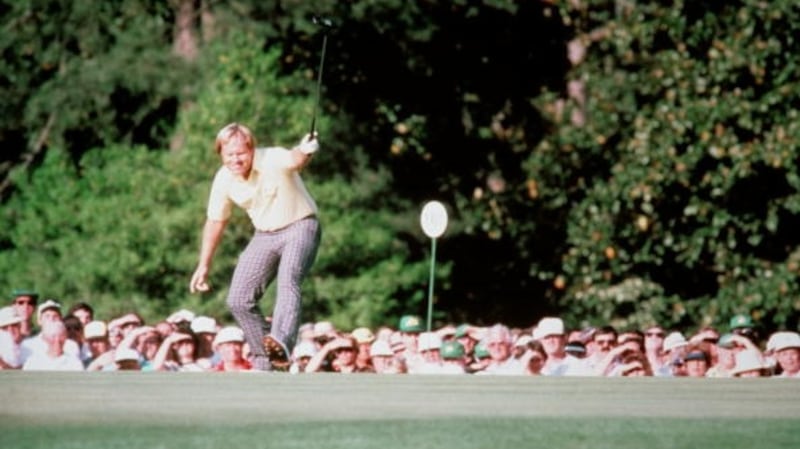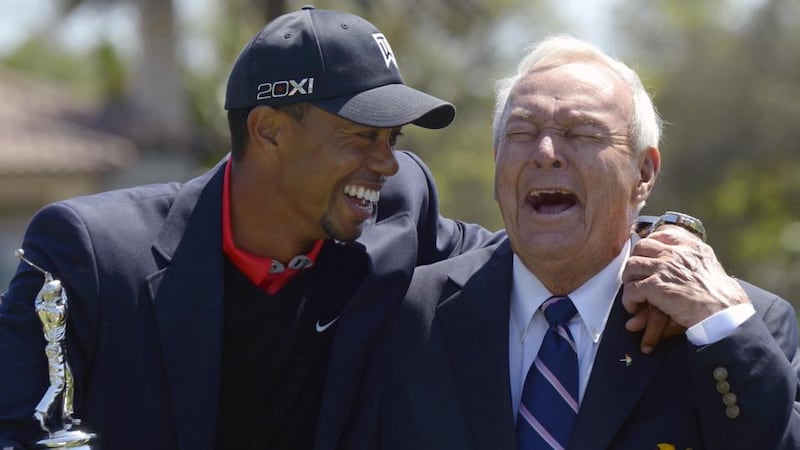For the television interview, Phil Mickelson removed his aviator shades. Dressed in black and unshaven, he stared at the camera, his eyes startled and wide and his voice defensive. Behind him in Brookline stood the branded US Open backdrop.
“I would say to the Strada family ... I would say to everyone who has lost loved ones, lost friends in 9/11 that I have deep, deep empathy for them,” said Mickelson. “I can’t emphasise that enough I have the deepest of empathy and sympathy for them.”
That is the point golf had reached in June. The other names that joined him have been reeled off, Brooks Koepka, Bryson DeChambeau, Dustin Johnson, Sergio Garcia and more. But it was a beaten down Mickelson who had become the lightning rod for a game at war with itself.
The specific question he spoke to regarded Terry Strada, the national chair in the US of 9/11 Families. Strada, whose husband was among the thousands killed in the attacks, pleaded with the American golfers to reconsider their decisions to chase big cheques on the Saudi Arabia-backed rebel LIV tour, given the nationality of most of the plane’s hijackers.
READ MORE
There was a price for breaking the game of golf in two. Arguably the world’s most charismatic golfer was paying for it, answering questions at one of golf’s most prestigious tournaments on the Saudi Royal family and his place in a tour that will guarantee further enmity, division and legal dispute.
Mickelson is not the first professional golfer to grasp at opportunity. Nor is it the first time the game has reached a point of hostility and open rebellion against its organising body, the Professional Golfers Association (PGA). It has had to deal with insurgency before.
As the 1960s were coming to a close and the game was expanding, providing personalities and with television interest growing, the players’ willingness then to pull away from the PGA and organise their own tour offered a glimpse into what formed today’s professional soul.
The same instincts were at play then as now. Power and control of the game were at the heart of it. But also the money, where it went and who would get the lion’s share.

Now it is Mickelson bearing the brunt. In 1968 it was Jack Nicklaus, who emerged as a leader among the more than 200 players including Billy Casper, and the swashbuckling Arnold Palmer, who was then transforming how golfers monetised themselves with emerging lawyer Mark McCormack and his company IMG at his side. Tiger Woods would later become a client.
Then, as now, players were drawn to the prospect of greater rewards from an organisation that was ostensibly built by and run largely for club professionals, who ran golf shops and gave lessons.
In September 1968, the American magazine Sports Illustrated carried a now famous rebuttal from Nicklaus following a bitter and personal assault weeks before by Leo Fraser, the then secretary of the PGA.
The Nicklaus piece filled a full page of the magazine and contemptuously began as it continued for 1,514 words.
“That verbal attack recently unleashed on me by Leo Fraser, the secretary of the Professional Golfers Association, was, on the whole, inaccurate. Fraser did spell my name correctly — Jack Nicklaus. He even had my age right — 28. And he signed his own name properly — Leo Fraser. The rest of his cutting statement, though, was a personal assault.”
Nicklaus outlined how Palmer had flown to Washington to address the executive committee of a hard-nosed PGA and offer his solution to a dispute which would last for two years.
Palmer proposed a separate, self-governed, self-controlled section for the touring pros under the umbrella of the PGA. It was almost identical to the proposal made to the PGA by the players over the previous few months.
By then the American Professional Golfers (APG) had already been set up by players in rancorous opposition to the PGA and Nicklaus was its figurehead. Not yet 30 years old, he had already won The Masters three times, the US Open twice and the PGA and British Open championships.
In his response to Fraser, he outlined with dismay how only 56 touring professionals were in the starting field of 168 players at an event in San Antonio.
When asked about the ratio, Nicklaus replied: “It’s absurd and unfortunate.” Only a third of the players at the PGA were regular tour competitors, the best players in the world. The PGA’s antiquated qualifying system, he argued, prevented top players such as Bob Murphy, Lee Elder and Deane Beman from playing.
Nicklaus was exempt from qualifying for the PGA tournament and wanted a proper tour representation at the professionals’ own championship. He reasoned it could not be the number one event when many of the top players, the tour players, could not tee up a ball.
Battle lines were drawn with PGA president Max Elbin leading the old guard. He was supported by the non-touring members of the PGA as well as a number of the game’s legends such as Walter Hagen, Sam Snead and Nicklaus’s boyhood idol, Bobby Jones.

The most powerful player in the game at the time, Palmer, was caught in the middle. As he was selling his branded golf clubs in pro shops all over the United States, he also needed to be seen supporting the club professionals and walked the middle ground. At the time numbers broke down to about 200 playing professionals and 6,000 club professionals.
But as the PGA knew, Sam Gates, a New York lawyer retained by the players knew, the sponsors knew and the LIV Tour now knows, money and attention follows what Gates called “the dancing girls”.
Finally in December of the second year, bruised and fatigued, hostilities ceased. The PGA formed a separate Tournament Players’ Division. A commissioner would run the tour and answer only to an agreed board. All the APG contracts, and their tournament schedule, were transferred to the PGA and all pending litigation was dismissed.
It worked. The following decades brought glamour and money. In 1968, Billy Casper was the leading prize money winner with $205,169. Since then, Tiger, the leading money winner 10 times, on three occasions won over $10 million in a season.
Mickelson, who earned $94 million on the course during his PGA Tour career, was reportedly offered $200 million to make the jump to LIV. Former world number one, Johnson, earned $74,276,710 on the course in his career but signed to a four-year contract worth a reported $125 million.
Most recently in a Californian district court, Talor Gooch, Hudson Swafford, and Matt Jones, who joined LIV Golf, sought the court’s protection from tournament suspensions imposed by PGA under the terms of the Tour regulations the golfers agreed to.
They filed a motion for a temporary restraining order, hoping to play in the end of season FedEx series. Theirs was an antitrust and breach of contract case against the PGA Tour.
They claimed the PGA Tour used regulations to exclude LIV Golf from the professional golf market and kept players from contracting with LIV, including two-year suspensions and threats of lifetime bans from the PGA Tour.
US district court judge Beth Freeman denied the restraining order. The players didn’t play in the FedEx and a date for the antitrust lawsuit was set for September 2023.

“As the Tour’s monopoly power has grown, it has employed its dominance to craft an arsenal of anticompetitive restraints to protect its long-standing monopoly,” the rebel players argued. “The Tour has done so in an intentional and relentless effort to crush nascent competition.”
That the money comes from Saudi’s Public Investment Fund is not a question for the courts. But people rightly ask if Mickelson’s “deep, deep empathy” for 9/11 victims extends to the murdered Washington Post columnist Jamal Khashoggi and the 81 people beheaded in March. Ethics have also prompted some golfers to look at their device and ask, “Hey Siri, what’s sportswashing?”
The PGA Tour have called into question the competitive integrity of the LIV events, banking on fans paying not to see top players hit golf balls but compete against each other in meaningful events, their jewels, the four Majors and the Ryder Cup.
In court it was pointed out that five players from the top 10 of the PGA Tour’s Player Impact Program (PIP) in 2021 signed with LIV. The PIP represents players who move the needle most in the professional game with brand exposure, social media interaction and internet searches.
Woods beat Mickelson to win inaugural award claiming the $8 million first prize despite not playing a single round on the PGA Tour in 2021. Incredibly, golf isn’t always about the game.
Mickelson, DeChambeau, Koepka, Garcia and Bubba Watson, like Nicklaus and Palmer once were, are the “dancing girls” as are PGA loyalists Rory McIlroy and Woods.
As the landscape continues to change, Cameron Smith, this year’s Open champion, seems set to join with $100 million splashed his way, while Mickelson continued to face push back at the LIV event in Donald Trump’s course in Bedminister, New Jersey at the end of July.
As he addressed the ball to hit an iron at the first tee, a spectator screamed “do it for the Saudi Royal family”.
Mickelson, in black shoes, black pants, black shirt, black hat and the aviator shades in place, stopped, stood back, looked out over the fairway and studiously ignored the heckler among a thin line of spectators.
Dressed for the part of anti-hero and with the free competition case to play out in the freer wheeling courts of California, it is too early to know what a critical mass of players looks like. That and if Mickelson will emerge from it like the boys of 1968. A visionary or a villain.















